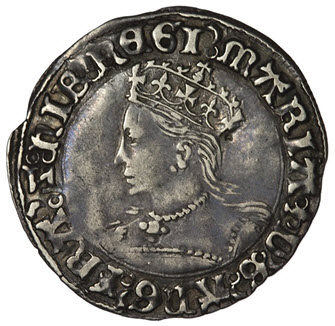Born in 1516, Mary was the daughter of King Henry VIII of England and his first wife, Katherine of Aragon. Mary was the fifth of six children born to her parents, including two other girls and three boys, but the only one to survive infancy. Mary was a source of great pride to both of her parents, who doted on her. Henry, particularly, seemed to love showing her off to visiting ambassadors and, on at least one occasion, boasted to a visiting dignitary that his toddler daughter never cried. The court also loved her.
Mary received a top-notch education, learning French and Spanish (thanks to her mother, who was from Spain), dancing, singing, and all the courtly arts. There is some evidence that the young princess may also have been taught Latin and Greek, which were considered the classical languages of the time. She was clearly highly intelligent, which was evident from an especially young age. On one recorded occasion, at barely four and a half years old, Mary gave a concert on the harpsichord to visitors to the court and impressed all who were present with her talent and ability. Today, she would likely be considered a gifted child or perhaps even a child prodigy.
Mary had a happy childhood as an only child with the privileges of being a genuine princess and with two parents who clearly adored and loved her. Yet, by the time she was nine years old, her parent’s marriage was held together only tenuously. It was clear by that time that Katherine of Aragon would probably not have any more children, and Henry VIII still did not have the legitimate son he so longed for. While English law did not prohibit a daughter from inheriting the throne (as it did in other European countries like France), Henry still wanted a son to become King in his place one day. He had an acknowledged illegitimate son by his mistress, Bessie Blount, but this boy was not eligible to inherit the throne as he was not born to Henry’s legally wedded wife. As Mary and Katherine would soon discover, Henry would do almost anything to get that legitimate son he so desired.

This quest for a legitimate son would eventually ruin Mary’s seemingly perfect childhood and family. While he arranged many marriages for her over the years, beginning in her infancy, none of those marriages ever came through for Mary as her father’s political and personal ambitions changed and shifted seemingly with the wind. He sent her to Wales for three years to oversee the affairs of the kingdom there, presumably with the intention of eventually declaring her Princess of Wales and his official heir, but Mary went back to court in London after her time in Wales with no official title or announcement concerning her royal status. When Mary was a teenager, Henry finally decided he wanted to divorce Katherine. This pitted Mary and her father against each other for the first time in her young life.
Because Mary would not accept her father’s new marriage to Anne Boleyn, nor give up using her title of Princess after Henry declared his marriage to Katherine invalid and Mary illegitimate (he wanted her to go by the title Lady Mary instead of Princess Mary), Henry retaliated by separating Mary and her mother and prohibiting them from seeing each other (and they never met in person again), though they did write to each other for a time, until Henry banned this, as well.

Henry even briefly considered having Mary executed for treason, supposedly at Anne’s urging. He did not allow Mary to visit Katherine when it was clear Katherine would soon be crossing over to the other side. Mary only capitulated to Henry’s demands after Katherine crossed, but she always felt guilty about it afterward. By acknowledging Henry’s marriage to Anne as valid, she believed she was betraying Katherine.
Soon after Katherine’s crossing, Henry grew tired of Anne, too, as she had also failed to give him a son. He had Anne executed on trumped-up charges of adultery and treason and quickly remarried Anne’s lady-in-waiting, Jane Seymour. Mary enjoyed a better relationship with Henry after this, as all of his wives after Katherine crossed was able to be considered his legitimate wives in Mary’s religious views. She enjoyed good relationships with all of her step-mothers from Jane onward, especially with her final step-mother, Katherine Parr, who encouraged Henry to be closer to all three of his legitimate children (whether he considered them legitimate or not).
After Henry VIII crossed to the other side, Mary’s younger half-brother Edward (Jane’s son) became King at only nine years old. The Protestant faith was pretty firmly established among a large part of the English population by then, and Edward VI was brought up as a Protestant. Mary was still firmly Catholic. Edward gave her special permission to celebrate mass in her own residence when he banned it in the rest of the country (after they argued about it, which ended with Mary in tears). Edward wanted England to remain Protestant and tried to leave the crown to his first cousin, one time removed, Jane Grey, who was also a Protestant, and his same age.
Edward crossed to the other side when he was fifteen years old, and Jane did briefly take the throne. Mary had the support of the people, though, and she was able to take the throne as Mary I after only nine days of Jane being Queen. She was finally able to achieve her lifelong dream of getting married by choosing her own husband, Prince Phillip of Spain. This made her Queen of Spain for a couple of years when Phillip became King of Spain during their marriage. She did as Edward knew she would and tried to force England to become Catholic again and to reconcile the country with the Pope. Her persecution of the Protestant people of England was rather brutal at times, which is why history often refers to her today as “Bloody Mary.”
After going through two phantom pregnancies (one of which even produced a growing belly, movement like a baby kicking inside, and lactation), it was clear she was not likely to have children. Phillip, embarrassed by these phantom pregnancies, which were probably produced by Mary’s intense desire to have a child, be a mother, and produce a Catholic heir for England, went back to Spain, breaking Mary’s heart. She genuinely loved him, though the union seemed to only be a political one for Phillip, who was quite a bit younger than her. Mary reluctantly admitted she had little choice other than to make her half-sister, the Protestant Princess Elizabeth, her heir.
Mary crossed to the other side, probably of a stomach tumor of some sort, in 1558 at the age of forty-two. Her reign as Queen had only been a five-year one. Mary was a highly intelligent woman who seemed to genuinely mean well and who wanted more than anything to do right by England and, more importantly, to be loved. She was also, not counting the disputed reigns of Empress Matilda and Lady Jane Grey, the first Queen Regnant of England, ushering in an era where crowned queens in England would no longer be considered an anomaly or curiosity. She proved women could wear the crown and rule just as well as men could in England. That is her most lasting, important legacy to England and even to the world.






